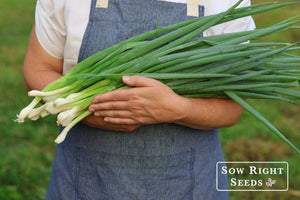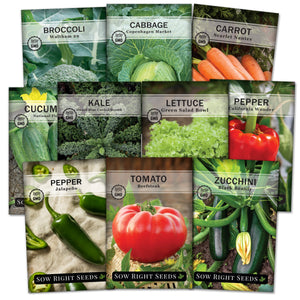Watering 101: When and How to Water Your Garden for the Best Results
Beginner gardeningAre you wondering how often you really need to water your garden—or if you might be overdoing it? It’s a common question, and the answer depends on your soil, weather, and what you’re growing. In this article, we’ll cover how to tell when your plants need water, the best time of day to water, and how to avoid common mistakes.

Garden Watering Questions
What is the best way to water your garden?
Water. We can't live without it. Neither can our plants. However, watering your garden can be tricky. Too little water can kill your plants, but so can too much water. So, how do you give your plants exactly what they need?
To have healthy, thriving plants, focus on watering the roots. The roots are the water-gathering part of the plant. It is through the roots that the plant takes up nutrients.
The best way to water your vegetable garden is low and slow. If you think of the roots reaching deep, you want the water to be deep. Not shallow surface water.
When the seeds first germinate and sprout, watering is frequent and shallow. However, once roots are growing, all watering should focus on the root system.
Too much water can make the soil too wet, and the roots won’t be able to take in oxygen. If the ground becomes too dry, the plants will get stressed. Stressed plants may produce small fruit or none at all. They may bolt, turn bitter, or wilt and die.
The parts above the ground are the leaves and flowers. The leaves use photosynthesis to turn the water into sugar and oxygen. Healthy leaves contribute to the development and strength of the plant. Wet leaves that stay wet can lead to disease.

Efficient ways to water a garden.
Efficient watering not only benefits your garden but also helps our environment. Instead of allowing water to spray over a large area and onto streets and sidewalks, you can direct water to the roots. When you use efficient watering methods, you'll have less evaporation, use less water, and avoid soil erosion.
The best watering system for vegetable and flower gardens is a drip system or soaker hose. These allow a slow flow of water around the plant roots that soaks deep. Deep soaking encourages deeper root growth. On the other hand, shallow watering, like how you water a lawn, keeps roots higher and more susceptible to drought.

For low and slow watering, you can also have a row watering system where you turn the hose down low and let the water flow down a row. This method is what I learned from my grandmother. It took a lot of patience and she would use a hoe to make sure the channel was clear for the water to flow to the end of the row. Again, the water flow should be slow enough that the water will soak in as it goes and not just wash away the soil.

I have an automatic sprinkling system for my lawn, isn’t that good enough?
It’s not a good idea to water your garden with a sprinkler like you do your lawn. This method of frequent but shallow watering doesn’t soak in deep for plant roots. It also puts a lot of water on the leaves and flowers, where more evaporation will occur. It can be deceiving because the top layer of soil will be moist, but the water never gets more than a few inches deep.

How much water does my garden need?
Different plants have different watering needs, but the general guideline for vegetables is one inch of water per week. Starting with that guideline, adjustments can be made for dry, hot days and plants requiring more water when fruiting or flowering. Plants such as melons will need a lot of water, while herbs and Mediterranean plants will do well with less water.

How often should I water my garden?
How often you water your garden depends on how quickly it dries out. If the soil stays moist, then once a week is sufficient. However, twice a week is more realistic if your soil is more sandy. Soil covered by mulch will retain moisture longer, while sandy, well-drained soil will need more frequent watering.
Containers need to be watered more frequently. Most containers will need to be watered daily, and some twice a day. The exact frequency depends on the size and material of the container. Plastic containers won’t dry out as fast as terra-cotta.
Vegetables and flowers do best with consistent watering. For example, root vegetables such as carrots need to stay moist to maintain their shape and not have split roots. Consistent watering is also essential for tomatoes so they don’t dry out and get end rot.
If you are gardening in a climate that rains frequently, a rain gauge can be helpful. This will let you know if your garden is getting enough water from the rain.

How do I know if my garden is getting enough water?
To determine if your garden needs water, check the moisture level. The top inch can be dry, but the soil should be moist below the first inch or two. An inch of water is equal to 0.6232 gallons per square foot or 62 gallons for a 100-square-foot garden. Since gardens typically need an inch of water per week, it’s worth figuring out the rate of water flowing from your hose. That way, you will know how long to let the water run.
To determine the rate, turn your hose on to the flow you use when watering. Then, put the hose into a 5-gallon bucket and set a timer. When the bucket is full of water, see how long it took to fill. Then you know that is how long you need to leave the hose running in the garden to get 5 gallons.

Does it matter what time of day I water?
Watering early in the day is best, but if plants need moisture, water. Don’t wait for a forecasted rainfall. Plants need consistent watering. Don’t wait for them to get stressed. Recommendations to avoid watering during the hottest part of the day is that the water evaporates before it sinks into the soil. Early evening is also a good time to water. This gives the water time to soak in before evaporating in the hot sun the following day. However, this may increase the problems with mildew and slugs or snails in some locations.
Garden Watering Checklist
Aim for 1 inch of water per week (adjust for soil and weather)
Water deeply and less frequently to encourage strong roots
Use early morning hours to reduce evaporation and disease risk
Check soil moisture a few inches down before watering
Adjust frequency based on soil type:
Sandy soil = more frequent
Clay soil = less frequent
Use drip irrigation or soaker hoses for efficient watering
Add mulch to retain moisture and regulate soil temperature
Avoid overwatering to prevent root rot
Observe plant health and local climate to fine-tune your routine
Water is an essential garden need, and getting it right will take some adjustments. Start with one inch of water per week and make adjustments as needed. If it's dry, it's time to water. Time your watering to minimize evaporation, and use drip irrigation or soaker hoses to deliver water directly to plant roots. Overwatering can lead to root rot and other issues, so ensure the soil has adequate drainage. Adjust your watering practices based on plant needs, soil conditions, and local climate to maintain a healthy garden.
Using these general guidelines of when and how to water your garden will ensure that you have a thriving garden all season long.
Written by Beverly Laudie









Leave a comment